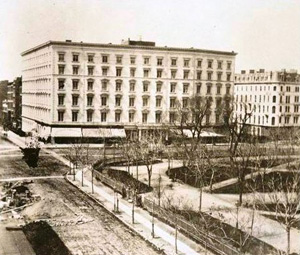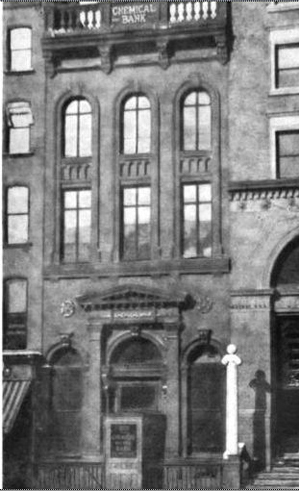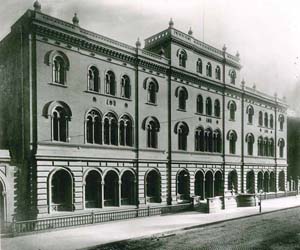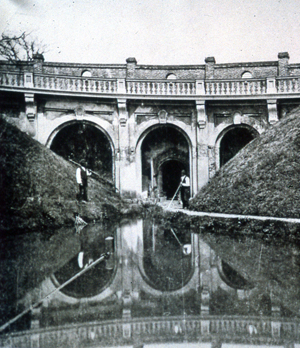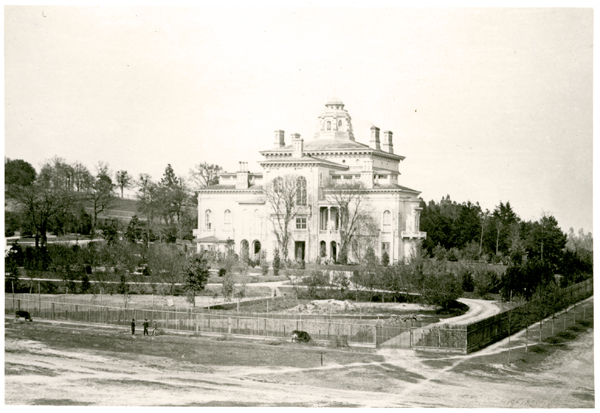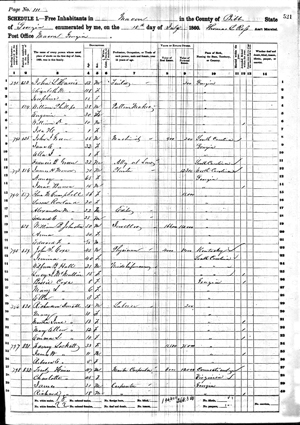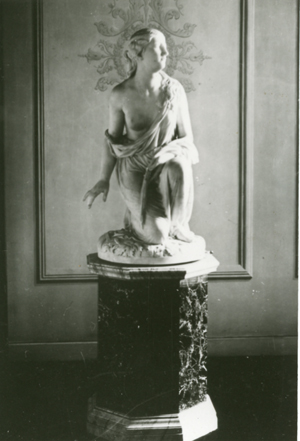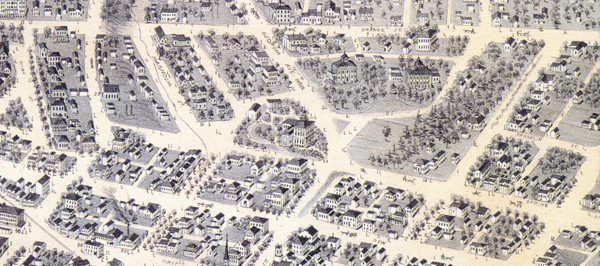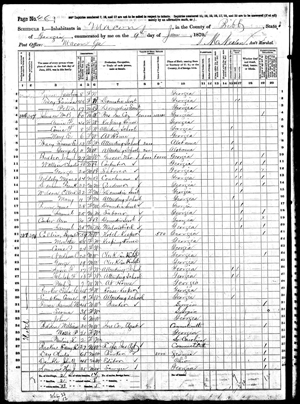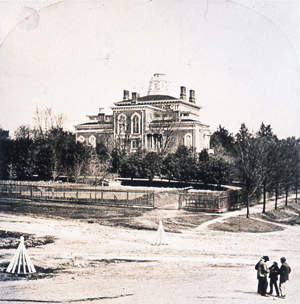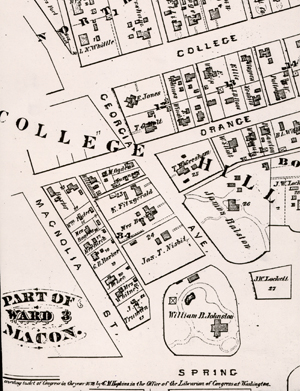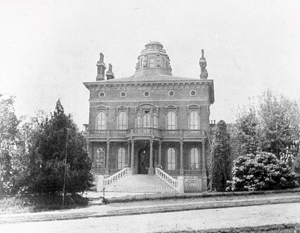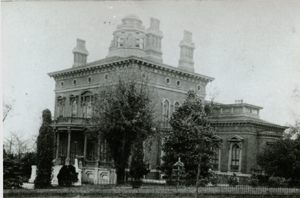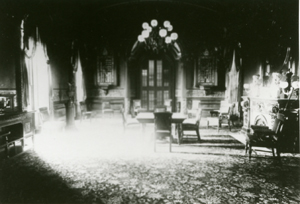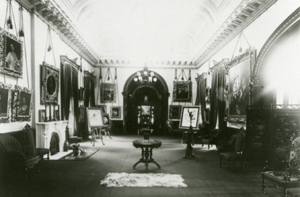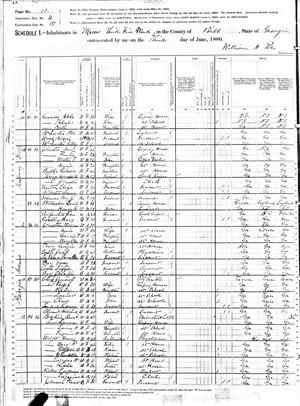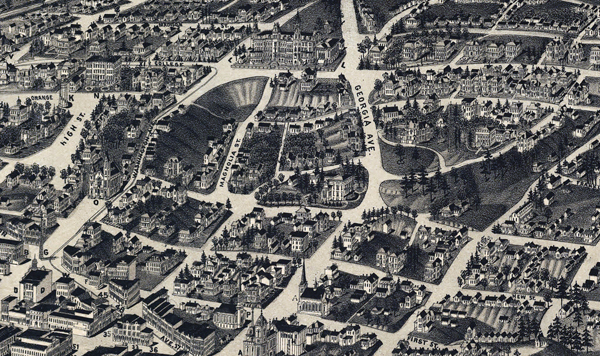By mid-September 1855, Johnston had left for New York to acquire plans and materials for the new house. With stops in Washington and Philadelphia to look for materials, he arrived in New York by the last week in September. The reason for Johnston's choice of architects for the house is not known but by the end of the month he wrote his wife that he had "employed Mr. Thomas to draw the plans for a house and he is said to be the most accomplished and tasty architect in New York . . . . Mr. Thomas says that my plan will make one of the best arranged houses he has ever seen and would be a splendid plan for a New York house."[1]
Thomas Thomas (1787-1871) was born in Wales and is believed to have come to New York in 1833. Little information survives on his life and career, although he was one of the founding members of the American Institution of Architecture in 1837, the predecessor of today’s American Institute of Architects. His son Griffith Thomas (1820-1878) was born on the Isle of Wight and received an academic education in England. In 1838, he immigrated to New York where he went into architectural practice with his father.[2] By the 1850s, the firm of T. Thomas and Son was the most successful commercial specialist in New York and, according to architectural historian Winston Weisman, "one of the busiest in the country." Between 1868 and 1873 alone, the firm was responsible for thirty-three large office buildings, insurance companies, and banks. Besides the Astor Library on Lafayette Place, one of the elder Thomas' most important works, their projects included the Moffat Building (1847-48), the Chemical Bank (1850-51), the Broadway Bank (1852-53), and the Lord & Taylor Store (1852-53), one of the first cast-iron commercial buildings.[3] Work on the Johnstons’ plans proceeded slowly with Johnston going "every day" to check the progress. In the meantime, he complained of being unable to order materials until the plans were done and so had to content himself visiting with various friends, relatives, and acquaintances.[4] On 25 October 1855, Johnston wrote Anne from New York that “Mr. Thomas my architect has 4 or 5 persons upon my plans and says that he will try and drive them through this week and I hope to get off from here in the course of 10 days.” By 2 November, the plans and specifications were complete and Johnston was "quite busy making contracts for some materials.”[5] Johnston would continue to actively manage construction of his new house, and in the process would make significant alterations to the architects' specifications, including building a masonry house rather than the wood-framed structure that had been specified. Johnstons' obituary credited him with designing his own house; certainly he played a major role. The great Renaissance Revival house that the Johnstons built 1855-1859 was a magnificent departure from the Greek Revival of the period and had virtually no parallels in the antebellum South. Beyond the spectacular architecture, it had a number of other refinements that, while taken for granted today, represented the pinnacle of residential comfort and convenience on the eve of the Civil War. The Johnstons’ house had three bathrooms with hot and cold running water, walk-in closets in the bedrooms, a fifteen-room speaker tube system, a large in-house kitchen, central heating, and an elaborate ventilation system that provided air-conditioning of the day. These and other such features set the Johnstons' house far apart from that which was typical at the time and mark it as one of the highest achievements of antebellum residential architecture in the country.[6] Although Johnston did not actually arrive back in Macon until late November 1855, work on the site at least had probably already begun. Removal of the old Tracy house to Cherry Street may have started although there is no mention of that in the few letters from that period. However, in January 1856, John Gresham as executor of Judge Tracy's estate purchased a lot at the corner of Orange and Magnolia Streets and a house was constructed there shortly afterward. That house, still standing at the corner of Magnolia and Orange streets, was where Judge Tracy's widow and their daughter Harriet lived out their lives. Little is known of how the Johnstons lived as the house at 2 Georgia Avenue was being constructed. A letter written by William Makepeace Thackeray to his wife while he was in Macon for a series of lectures in February of 1856 contains this description: I have been to see an old friend of yours and Granny's ...Mrs. Johnstone [sic] of the Rond Point [in Paris], with whom M. lived and who was an anatomy of a woman at Paris, now grown to be fat healthy and pretty with a pooty itty baby of 7 months old [Susan Mary] ....They are building themselves a house in this rambling lazy out of the way place, & meanwhile live in one of their negro houses in an uncommonly nice big room on the ground floor in which I felt I could instantly write novels.[7] Three months after Thackeray’s visit, on May 25, the Johnstons’ daughter Susan Mary died.[8] Her death, at barely six months of age, cast a pall over the house that was going up across the street.
Several changes to the carpenter's and mason's specifications were made either before or while the house was under construction. These included the elimination of "fan lights hung on pivots" as transoms above the interior doors. In addition, the specifications instructed the carpenters "to enclose as directed with old windows and doors.” The most significant change was from a wood-framed house finished with “clear narrow [3½"] weather boarding” to a brick house stuccoed to resemble stone blocks and then painted. By 1857 the house had begun to take shape and to attract local attention as well. An article in the April 4th edition of the weekly newspaper Georgia Citizen reported on a "tour" of new business and construction in Macon. The article briefly described ten residences, new or under construction, including the “elegant mansion of Wm. B. Johnston, Esq., estimated to cost, exclusive of equipment about $100,000. This will probably be the finest house in the state if not in the South, for use as a private residence.” It was certainly the most expensive: the cost of the other houses described in that article ranged between six and twelve thousand dollars.[9] The brick walls of the house were nearing completion in March of 1857 when, the Johnstons’ third child, William Butler Johnston Jr., was born, and over the next year, it would be roofed and work begun inside. But for a third time, the joy of a child was taken away when the boy died on 5 June 1858. By September of 1859, the house was nearing completion and Anne wrote to her sister-in-law Ellen Steele in Huntsville, Alabama, of her "fairy palace," writing [The house] is nearly finished, that is it will be completed about Christmas— we are not at all decided about furnishing this winter— probabilities all against it—if we do not, will continue where we are— What do you think? Mr. J. has bought me a sewing machine, which does finely and with which I am enchanted.[10] And although she did not mention it, she was already pregnant for the fourth time as they prepared to move into the new house. On November 11, 1859, Anne wrote Ellen again, urging her to come to Macon over the winter: I have not my new house in which to welcome you, but hope you will not despise the day of very small things—We propose to move in the basement the 1st of January—I suppose the whole house will be complete by that time, but as we will not furnish this year we will be obliged to confine ourselves to small quarters—The yard still looks very much like chaos—If I should live to be 100 and nothing unforseen occurs, I really think I will be comfortably fixed and quite well educated.[11] The house may have remained unfurnished and the grounds not yet landscaped, but the house was already a landmark in the city. In a "Ramble through Macon" that was published in the Macon Telegraph in April 1860 was this typically overwrought description of the house: On our way to the object of our early promenade, we came to the princely residence of Col. William B. Johnston just asst a Sun, emerging from his watery bed, poured out his golden Light upon it, and made the architecture look so airy and graceful, that we had to rub our eyes to convince ourselves that we were not in the sweet land of dreams. It seemed to us that we were beholding the unfinished work of some munificent and graceful fairy, who had been compelled by the morn to leave off her task before she had given the finishing stroke in causing fragrant gardens and fascinating statues to arise from the earth. It was, in short, a "splendid mansion, which can truly be called the palace of the South.[12]
THE JOHNSTON HOUSE, 1860-1888The Johnstons' joy over their new house must have been marred considerably by a smallpox epidemic that swept Macon early that year. In a letter to Ellen dated February 12, 1860, Anne states that she had "really been through quite a sea of troubles" because of the epidemic and that, although she an Mfr. Johnston had been vaccinated, the servants had not. I had no hesitation in remaining upon my own premises and taking care of the rest of my servants, preventing them being carried to the Rest House unnecessarily and sharing the entire isolation to which we curse all infected until the period for infection was past.[13]
The threat of infection was so severe that the servants were apparently all removed from the house and, as Anne wrote, "the old kitchen and all my kitchen furniture" had to be burned. In the meantime, with Anne pregnant, the Johnstons moved in with her Aunt Flora Campbell where they had "a comfortable wing" to themselves." When the enumeration of the 1860 federal census was taken in Macon in July of that year, the Johnstons were still living with her Aunt Flora. Ten days after that letter was written, Anne gave birth to Edward Tracy Johnston, their fourth child. From the beginning, however, the baby was not well. In a letter written to Ellen on 13 March 1860, Anne states her disagreement with the doctor's diagnosis that the child had scarlet fever, but she still felt compelled to seclude herself and the child for awhile. "I am afraid that I'll have the plague next as I have been actually beset with the presence or dread of disease the whole of this year.[14] Amid the increasingly vociferous debate over possible secession and war, it is not surprising that the Johnstons delayed final decoration of their new house. With Georgia's secession in January 1861, followed by the firing on Fort Sumter on 12 April and the death nine days later of the Johnston's fourth child, "the fine little fellow" Edward, that delay must have become indefinite. The nearly unceasing litany of disease and death in the Johnston and Tracy families continued in July 1861 when Anne's half-sister Caroline Matilda died, leaving her widower Dr. John S. Baxter and their nine-month-old son Tracy. Dr. Baxter never remarried and, beginning about 1870, he may have occasionally lived with the Johnstons at 2 Georgia Avenue. "Dear unc John" is referenced quite frequently in the Johnston letters. Anne wrote Ellen in September and again in October of 1861, saying in both letters that she wished to visit them in Huntsville but that "Mr. J. says he has no money." At the same time, Mr. Johnston was apparently ill as was Anne's brother Philemon, who had just returned to Macon. Anne expressed her frustration in the October letter: If it were not for my absolute fatalism, & stern belief that whatever is to be, will be I should most surely rebel.... so many of my loved ones have crossed the dark valley, that I would choose that those that remain should evermore be encircled with the arms of love.... I am not at all fond of keeping house, the truth is I am too old to begin and it seems rather an aimless existence, keeping such an establishment swept and dusted.... Send them [Ellen's daughters] to see me. Tell them not to despise the day of small things. We are only living in the basement.[15]
On 6 July 1862, the fifth of the Johnston's children, Caroline or "Carrie," was born and although she would live to adulthood, the parents, given the fate of their other offspring, were apprehensive about their daughter’s health for some time to come. And the toll on the Tracy family continued unabated, as Anne's "darling bro. Phil," former editor of the Macon Telegraph, was killed in the bloody battle at Antietam in September 1862. The following spring, her other brother Gen. Edward Dorr Tracy Jr. was killed at Port Gibson, Mississippi, in the run-up to General Grant’s great victory at Vicksburg. He left his widow Ellen Steele Tracy and two children, Susan Campbell (1858-1912) and Georgia Elizabeth (1860-1921). Continuing the family’s misfortune, Ellen Tracy herself died in April 1868, and the orphaned children were sent to Macon to be raised by the Johnstons. Finally in October 1868, Anne's last brother, Campbell, died, leaving only Anne and her half-sister Harriet remaining of the six Tracy children. With the end of the Civil War in 1865, Johnston apparently did not hesitate to take a loyalty oath and file papers requesting amnesty from prosecution for his activities during the war. Unlike the majority of Southerners, the Johnstons appear not to have suffered undue financial hardship in the early years of Reconstruction. Few Georgians could claim $140,000 in real estate in the 1860 census; fewer still could claim $200,000 in the 1870 census.
The Johnstons were also able to complete the furnishing and decorating that had been interrupted by the war. According to family tradition, the exigencies of war prevented full furnishing of the house and only the dining room furniture passed through the Union blockade. In fact, the dining room furniture is American Eastlake that the Johnstons probably acquired shortly after the war. Anne's statement in a letter written in October 1866 that Mr. Johnston, who was in New York, had "bought some furniture, more than I wanted" suggests that furniture was not long absent from the house.[16] There are several indications that changes were made to the house by the Johnstons at a very early date. These include the closure of the window high on the east wall of the walnut hall, which occurred prior to the walls being marbleized; the anomalous hardware on the door into Ruth's Room: and the several instances of very early distemper finishes in the house. The most significant change, however, was the complete removal of the original scored stucco on the exterior and its replacement with the red stucco rendered to resemble brick that is clearly visible in the 1876 photograph of the house. Probably due to incorrect formulation of the stucco, this finish failed at a very early date, necessitating its complete removal and replacement.[17] The replacement had faux mortar joints rendered in an off-white mortar over a red base layer that was colored and formulated to resemble red brick. Family tradition has stated that the Johnstons only lived on the ground floor of the house. While this was probably the case during the war years and early Reconstruction, certainly with the addition of the two Tracy nieces after 1868, plus brother-in-law John Baxter and, at times, his son Tracy, the enlarged household required use of the upper floors. Letters from the 1870s and 1880s suggest that Mr. and Mrs. Johnston had rooms upstairs as well. For example, Carrie wrote in 1885 that she is “in Papa's room by the fire while the other room is being aired, swept, and dusted.”[18] Mrs. Johnston wrote that same year that, after a visitor was announced by the maid Josephine, “I arranged myself and went down” and in 1888 that she “came down to breakfast this morning.”[19] The Macon newspaper reported on Susan Campbell Tracy's marriage to Dr. Appleton Collins in 1879, giving a glimpse of the Johnston house: From the church the bridal party repaired at once to the residence of Colonel William B. Johnston, where a most elegant reception was held. The handsome residence blazed with beauty, within were assembled the very elite of the city. In the centre of the picture gallery Dr. and Mrs. Collins received the congratulations of friends . . . . The elegant parlors were thrown open and the mansion never witnessed a scene more happy or an occasion more enjoyed. At an early hour supper was announced and an elaborate repaste [sic] served in the most elegant manner . . . . Most elegantly did Colonel and Mrs. Johnston do the honors of the occasion.[20] In letters of the 1880s and '90s, we find references to "the office," although we can only guess at its location. It seems to have been a center of activity and a favorite writing spot for Mrs. Johnston. It has been suggested that this "office" was the small Tracy house, relocated to the back of the property and later moved across Cherry Street. More likely, the office was in the basement, possibly in what is now referred to as the "old summer bedroom." In an 1884 letter, Anne gives another hint of their life in the house: I staid [sic] downstairs until 9 o'clock and then. . .went upstairs and read a novel until 12 o'clock. Mary Ellen was in the parlor with John Hage until 10, when she retired. . . It is quite cool and we have fire in the office.[21] And in 1892, in her last letter in the Johnston-Hay House collection, Anne Tracy Johnston leaves us perhaps a hint of her feelings about the house: There is no choice about this house, nothing but dirt upstairs and down. They have never finished upstairs because Mose has been in the yard and the [undecipherable] in the basement is a terror.[22]
In addition to family members, the Johnston household included a number of slaves before the Civil War. Always called "servants," even when they were enslaved, these people made habitation of the Johnston's great mansion possible and their role in the history of the site must not be overlooked. Anne Johnston herself, who as mistress of the household spent much of her time in management and direction of the servants, certainly was sincere in her recorded expressions of affection for the servants. Her treatment of her slaves in the 1860 smallpox epidemic noted above is but the earliest indication of what sort of slave-owners and, later, employers the Johnstons might have been. Yet the identity of many of the servants, particularly the enslaved servants of the 1850s, remains a mystery. The 1860 federal slave census lists William B. Johnston of the Macon District owning nine slaves: five adult males; one adult female, listed as "mulatto"; a teenage girl, also listed as "mulatto"; a teenage boy and another teenage girl. With only ages and no names listed in the census, very little else is known about these people, who were housed in three "slave houses," probably located on the estate or nearby. It is perhaps useful to note that two of Johnston's slaves were listed as being "fugitive from the state" in 1860.[23] The 1870 census provides the earliest references to the identities of some of the servants who were so necessary to the Johnstons' lifestyle in the house. Ten are listed that year as living on the Johnston estate and at least some of them had probably been Johnston slaves prior to 1863. Names, ages, occupation and literacy were listed for all of these people, which provides some important insights into the Johnstons' household staff. Three of the women—Ellen Wilson, Janis Brown, and Ann Carter—were listed as "domestic servants," probably within the Johnston household. Moses Golsby, who remained in the Johnstons' employment for many years and is the “Mose” noted in Anne Johnston's last letter, was listed as "coachman" in 1870 and continued in that position at least into the 1890s. Nothing is known about Frank Denham who is listed as "gardener" in the census. The extent of the Johnston estate would have certainly been far more than one man could maintain alone. George Wallace and Samuel Brown, who were listed as "laborers" in the 1870 census, probably worked at least partly, if not exclusively, on the Johnston estate. Certainly some of the African-Americans living on the Johnston estate in 1870 had other employment. One, Samuel Carter, was listed as "hotel worker" and Charles Wallace, George's father, was a carpenter, the demand for which would have certainly provided him with ample opportunity for work elsewhere. While he may have served as a sort of maintenance man for the Johnstons, it does not appear likely that his services as a carpenter would have been routinely required. However, it is possible that, since the carpenter was usually the foreman of construction, he may have been responsible for directing the final completion of the house after the Civil War.
The 1880 census showed four servants present at the Johnston estate. Additional research of this census is necessary as well as of the letters, one of which documents "Josephine" as Mrs. Johnston's maid. Whether or not this reduction in numbers of African-Americans living on the estate indicates changes in the layout of the estate or in the household staff, is not known but it is worth noting that the three slave houses listed in 1860 can not be accounted for in the earliest maps of the estate from the 1870s. The main servants' quarters was probably the structure shown near the spring house along Nesbit Place and quarters may have also been provided above the stables near the corner of Cherry and Nesbit. Both of these structures appear in the 1887 bird’s-eye map of Macon but were probably demolished when the estate was subdivided at the turn of the century. The servant most mentioned in the Johnston-Felton correspondence after the Civil War was "Mammy," who was an extremely important figure within the Johnston household. Of all the servants, she was the only one who resided in the Johnstons' household, living in the small bedroom on the second floor above the linen closet. Called "Mammy" or "Aunt" by the Johnstons, this woman, in effect, raised the Johnston children and grandchildren. A single reference to "Aunt Phoebe" in one of the letters is the only documentation for the woman who filled this role in the 1850s and '60s. Numerous references to Adeline Williams, the Johnstons' "mammy" of the 1870s and '80s, are contained in the family correspondence from the period. Apparently, she helped raise Carrie and Mary Ellen, perhaps assisting Aunt Phoebe or taking over her duties after the latter's death. She continued these duties with the Johnstons’ grandchildren until she was fired in 1891 for striking Carrie's children.[24] Unfortunately, neither of these women is present in the enumeration of the Johnston household in 1860, 1870, or 1880. As to the woman you speak of, I do not think the children need a governess, and suppose she would expect to be a kind of companion, eat at the table, etc. and would be decidedly in the way. For my part I prefer a servant to sew and attend to the children, who is accustomed to the life.[25] Governess or no, the Johnstons were not alone in the house, as seen through various references in the 1870s and 1880s. Christmas 1875, for instance, was described by Carrie in a letter to her uncle John Baxter. She indicated that all four girls were home and that, although Mrs. Johnston was ill with diphtheria, Christmas was roundly celebrated with Christmas Eve mass at Christ Church and then an exchange of gifts with friends at a neighbor's house. Carrie related that they then went home to bed so old Santa Claus could come down the chimney. Christmas morning dawned very warm, and a great deal brighter than usual, and we all hurried and dressed, and then went into Papa's room to see what old Santa Claus had brought us. I received a great many pretty presents.[26]
In 1883, Georgia Tracy married George Wadley, son of the president of the Central Railroad, and moved to Great Hill Place, the Wadley home at Bolingbroke, north of Macon. In addition, Mary Ellen was in school in Baltimore where she lived with "Cousin Biba" for at least a short time in the early 1880s. Nevertheless, Mrs. Johnston complained in January of 1884 that there has been endless dissipation in this house. The girls being up until three o'clock every night. Thursday night after the German [a local social club], the girls came in with their escorts and had cake, wine, fruit, etc. etc.[27] The Johnstons usually spent summer and early fall at various northern resorts, especially White Sulphur Springs ("the White") in West Virginia and Saratoga Springs in New York, with visits to relatives and friends in New York City, Buffalo, Baltimore, and other cities. During these periods, the house in Macon was closed and locked.[28] Carrie married George Duncan in 1884. During the early years of their marriage, George traveled back and forth to Danville, Virginia, where he was building a tobacco warehouse and processing plant. These absences, however, did not delay the arrival of the first Johnston grandchild, William Butler Duncan, who was born at the Johnston house in January 1885. By May, when Carrie and "the little man" returned to Danville, the child was the object of intense devotion. His death in June of that year was a severe blow to the family, bringing back memories of another generation’s losses.[29] In September 1886, Carrie’s second child, George Washington Duncan Jr. was born. Two other Duncan grandchildren—Annie Tracy and John Baxter—followed, both of whom may also have been born at the Johnston house, since George Duncan was still in Danville through part of this period. The Duncans, or at least Carrie and the children, lived at 2 Georgia Avenue until they moved into their new house at 276 College Avenue in 1891. On 20 October 1887, William Butler Johnston died after a long illness. He was 78 and was buried in the Johnston family plot at Rose Hill Cemetery. In his will, he left his "household and kitchen furniture, silverware, brick a brack [sic], paintings, statuary and books ...without inventory or appraisement" to his wife and a bequest of $4,700 to his nephew Walter T. Johnston "for services rendered." The remainder of his estate, "real and personal, notes, bonds, and stocks" was to be divided in equal parts between his widow and two daughters, with John Baxter named as trustee for Carrie and Mary Ellen.[30] Anne Tracy Johnston died on 1 April 1896. In her will she named John Baxter as executor and, after $5,000 bequests each to Susan Tracy Collins and Georgia Tracy Wadley, left the entire estate to Baxter in trust for Carrie and Mary Ellen, with a specific statement that no inventory of the property be made.[31] Baxter's death in October of that same year no doubt complicated settlement of the estate, and it was not until August 1901 that a formal division of the property between Carrie and Mary Ellen was made, although it had been surveyed for division in 1897. In the settlement, Mary Ellen received the house and the Spring Street end of the block of property assembled by her father. Carrie received the Nisbet Place end of the block and some cash in the settlement.[32]
1. Johnston letters, #028, 031, and 031b.
|
